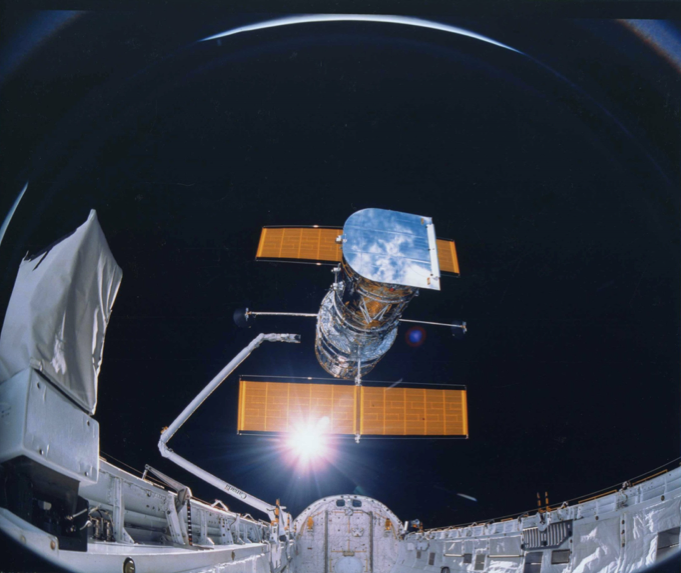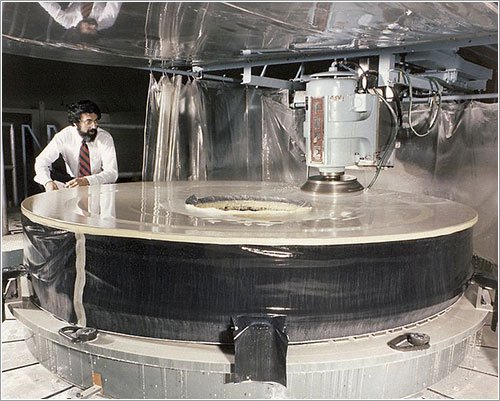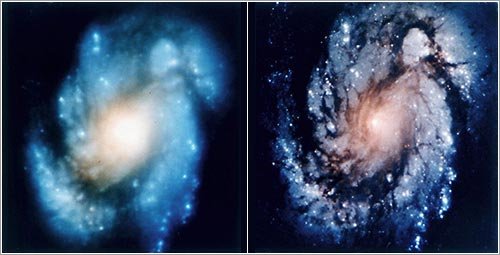Slowly and carefully, the automatic arm of space shuttle Discovery put into orbit the Hubble Space Telescope. It was April 25, 1990. The telescope had been built for more than a decade at a cost of several million dollars.

They had never made a mirror as careful or as expensive as its main mirror of 2.4 meters, having a central opening through which passes the light that comes from the secondary mirror. Its development had been an impressive scientific achievement (or so it seemed).

You can see in the image the aperture and the technicians in an enlarged image due to the parabolic shape of the mirror. Credit: NASA
Shortly after the launch, the scientists discovered that there was a problem with the mirror. The light that reached its end was focused about 4 centimeters behind the light that reached the center and the images produced by the telescope were blurred. A minuscule error in the design measures was the cause of the problem.
The mirror during its polishing. Credit: NASA

The company responsible for constructing the mirror had made a mistake in polishing the mirror, its edges were too flat at 2.2 micrometers, which caused spherical aberration, that it was a distortion in Hubble's main mirror, which means that instead of concentrating on a point in the mirror, it spreads throughout the mirror, causing blurry images.
The hubble was repaired during the first service mission in December 1993. Fortunately, this telescope was built to be repaired in space. The scientists created a tool called COSTAR that basically was a lens that could counteract the error.

THE COSTAR (Corrective Optics Space Telescope Axial Replacement)-- Credit:NASA

Produced blurry images similar to a myopic vision (left image). After the installation of COSTAR (right image). Credit: NASA
In December of 1993, the telescope began to send its first impressive images of the universe. Now you can bring us photos of the universe with which we could only dream.
Yet it is a warning to scientists, and for those who aspire to be, that precise and careful measurements can be the difference between success and scientific defeat.
Hubble 3D is a spectacular documentary about these maintenance missions
Previous articles
- Tools and the Sciences - The exploration of the Earth
- Tools and the Sciences - The exploration of the Universe
- Tools and the Sciences - Exploring the Microscopic World
- Measurement and science - The metric system
- Discover the questions that scientists ask: Microscopic, macroscopic and global
References website
https://en.wikipedia.org/wiki/Hubble_Space_Telescope
https://elpais.com/diario/1990/08/11/sociedad/650325609_850215.html
http://www.microsiervos.com/archivo/ciencia/el-dia-que-le-pusieron-gafas-de-miope-al-hubble.html
http://www.geocities.ws/edug2406/hubble_graf.htm
http://danielmarin.naukas.com/2011/03/11/ov-103-discovery/
http://www.imagenoptica.com.mx/pdf/revista30/hubble.htm
Being A SteemStem Member
Dear @osmerj, very interesting your post. It shows us the importance of measurements.
During a measurement many factors must be considered, but from my experience, the following are of great importance and should be monitored at all times: the observer (skill of the person performing the measurement), the measuring instrument (calibrated and with the characteristics corresponding such as: precision and accuracy), work procedures (updated, approved according to international standards with their correct application) and environmental conditions (control of parameters that may influence the measurement such as environmental temperature and relative humidity).
Thanks for sharing your work. Successes!
All those factors are important. In this case, the commission attributed the faults mainly to Perkin-Elmer, NASA discovered that it had not used its best opticians or adequately supervised the process of construction of the mirror. All this because only one lens was out of position 1.3 mm. What delayed such a large project for 3 years. Three years that would have been used for space research, instead of the manufacture of a corrective lens.